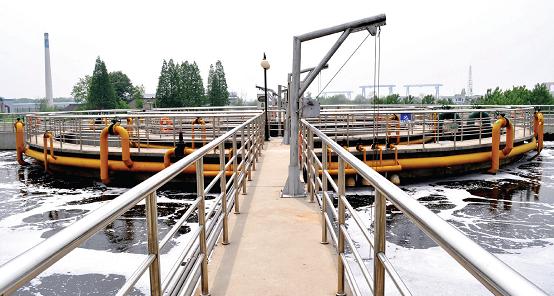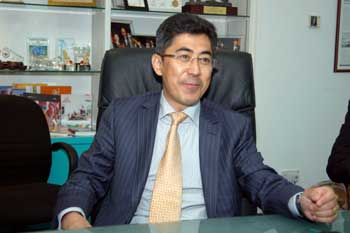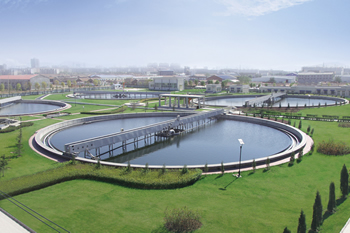 Hankore has been raising money from the issue of Multicurrency Medium Term Notes and share placements to fund its capital-intensive investments in the high-growth water sector. Its impending merger with China Everbright International augurs lower cost of funds and a stronger project expansion pipeline. Company photo
Hankore has been raising money from the issue of Multicurrency Medium Term Notes and share placements to fund its capital-intensive investments in the high-growth water sector. Its impending merger with China Everbright International augurs lower cost of funds and a stronger project expansion pipeline. Company photoTHE EXPANSION PATH of Hankore Environment (BIOT SP) and SIIC Environmental (SIIC SP) is similar to that of Beijing Enterprises Water Group (371 HK), whose profits increased rapidly after a state-owned enterprise emerged as a major shareholder and began to inject its assets into the company.
Some background on Beijing Enterprises Water Group (BEWG): With a market cap of HK$39.2 billion (S$6.5 billion), it is one of the largest water sector stocks on the Hong Kong Stock Exchange.
In 2013, BEWG acquired about 6 million tons per day (mtpd) of new water treatment capacity, including 1.02 million injected by its parent.
For 2014, the BEWG management has a capacity expansion target of 2.0 mtpd and will consider projects with returns of IRR 10% or more.
Standard Chartered Bank believes that the strong growth momentum in the PRC water sector will continue into 2014, boosted by government stimulus.
But this sunrise industry has two challenges: huge capital outlay and high standards imposed by government customers - who grant tenders based on tenderers' track record in construction and operations, as well as their financial muscle and reliability.
 "Our earnings will improve even more with the lower cost of project funding now that CEI is in the picture," said Hankore executive chairman David Chen. NextInsight file photo“There is now an industry consolidation where the BOT water treatment sector will be dominated by large players,” said Hankore executive chairman David Chen during a recent meeting with NextInsight.
"Our earnings will improve even more with the lower cost of project funding now that CEI is in the picture," said Hankore executive chairman David Chen. NextInsight file photo“There is now an industry consolidation where the BOT water treatment sector will be dominated by large players,” said Hankore executive chairman David Chen during a recent meeting with NextInsight.He was explaining the advantage of Hankore's impending merger with China Everbright International (CEI).
Post-merger, CEI will hold more than 50% of Hankore. Also, CEI's asset injection will double Hankore's wastewater treatment capacity.
According to a JP Morgan report on 2 Jan, CEI has wastewater treatment capacity of 1.9 mtpd while Hankore has 1.8 mtpd.
One of CEI’s wastewater treatment projects, at Jinan, has a daily capacity of 500 tons, which is two to three times the size of Hankore’s largest project (200 tons a day).
Several conditions in the industry favour large players: Economies of scale, cost of funds, and track record.
♦ Firstly, larger projects tend to have lower IRR hurdles.
♦ Secondly, state-owned players can afford larger project investments as their relatively low cost of funds makes it more feasible to use higher leverage.
This is true for CEI, as it is part of a larger entity which owns the China Everbright banking group. “Cost of funds for state-owned water treatment players is only 4% or less a year, compared with 7% to 8% for Hankore before the merger,” said Mr Chen.
 CEI's asset injection into Hankore includes its 500 mtpd Jinan Waste Water Treatment Project, China’s first project in a provincial capital that is fully in compliance with the national Grade 1A discharge standard.
CEI's asset injection into Hankore includes its 500 mtpd Jinan Waste Water Treatment Project, China’s first project in a provincial capital that is fully in compliance with the national Grade 1A discharge standard.The facility is a municipal Gold Cup demonstration project, and was ranked by the Ministry of Housing and Urban-Rural Development of the PRC for two consecutive years as number one among 36 cities in the category of city waste water treatment. Company photo♦ Thirdly, water treatment projects are contracts for public works granted by the municipal government rather than a commercial entity.
So, factors other than tender price determine who gets the tender.
These factors include track record in construction, operation, financial muscle and reliability.
“We can’t compete with China Everbright International,” conceded Mr Chen.
This is not to say Hankore has no strengths.
CEI agreed to the merger because of the strength of Hankore’s management and operational efficiency.
Hankore has won several water sector accolades in recent years, and one of its wastewater treatment plants in Shandong was awarded "Model Unit in Performance Assessment of Wastewater Treatment for 2011 in Shandong Province".
The merger also gives CEI an enlarged footprint on China’s water sector map.
CEI’s water treatment projects are in two provinces: Shandong and Jiangsu.
Not only does HanKore have investments in Jiangsu and Shandong, it also has projects in Beijing as well as the provinces of Shaanxi and Henan.
Recent story: China BOT Water Treatment Players @ 15-30 Times PE On S'pore Bourse








Comments
The future of china water treatment industry will be dominated by a few large SOE players as management of water treatment may soon require a license issued by ministry of environment, creating a huge barrier to entry for the smaller and private enterprise